Advantages and Limitations of Modular Fiber Optics–Based Low-Resolution Raman Spectroscopy Systems
Raman spectroscopy is going through a major revolution with the continuous introduction of new fiber-based modular systems for low-resolution applications. More and more scientists are discovering what Raman spectroscopy can do for their research, education, and commercial applications thanks to the low costs and flexibility this new technology is providing. New applications and prospects are presented each day, and it is important to understand the advantages and limitations that this user-friendly analytical technique can provide to address these opportunities with a scientific approach.
The combination of the main advantages of Raman spectroscopy with the exponential reduction of the instruments' capital cost keeps transforming the use of this technique. Exciting, innovative applications by scientists and engineers are transformed daily into instruments for QC technicians; medical, law enforcement, and homeland security personnel; and other nonspectroscopists. Thus, Raman spectroscopy is being exploited in a fashion never before intended because it was a complicated and expensive vibrational spectroscopy technique. Common "out of the box" applications include raw materials identification, forensic testing of materials and illegal drugs, explosives and other hazardous materials detection, cancer screening, and dialysis monitoring and process control.
To use low-resolution Raman spectroscopy technology successfully in novel applications, the instrument developer must understand the advantages and challenges that the technique presents for the application. After this, the engineers and scientists must use a proper analytical method development technique to generate an application that is accurate, repeatable, and dependable. The market that the new instrument will serve will influence such method development greatly. If the Raman spectrometer will be used to analyze raw materials or to differentiate polymorphs in the pharmaceutical industry, the method development should comply with official guidelines and regulations dictated by government agencies such as the FDA. Another complicated case is a common forensic application related to the identification of illegal drugs. In this case, the developer should have access to these drugs or thorough spectral libraries to design and program the required chemometric algorithms that will allow the instrument to identify unknown samples on the street. Because process control is one of the best potential markets for small, modular instruments, proper guidelines for method development can be adopted from the Process Analytical Technology (PAT) initiative launched by the pharmaceutical industry and the FDA.
The method development should include the following steps: method development plan, sample information, application background, laboratory testing development, writing standard operating procedure, validation of the procedure, calibration requirements, definition of the application's analytical capabilities, and implementation. These steps are necessary to determine what the method will accomplish, how results will be obtained, and whether the method can achieve the required use by the intended user under the designed conditions and at all times.
In the case of Raman spectroscopy, the main advantages of minimal sample preparation, analysis through optically transparent containers, the ability to analyze organic and inorganic materials in solid or liquid phase, and the fact that it is a nondestructive technique that is impervious to water content interference should be considered when deciding to use the technique. On the other hand, the same advantages that the technique brings to the table also can be major hurdles that an application has to endure to be viable for commercial use. The main limitations inherent to the Raman effect and vibrational spectroscopy are fluorescence and sensitivity. The method developer should consider the appropriate laser excitation wavelength and power to keep the fluorescence of a sample at a minimum and be able to increase the integration time of the analysis to increase the signal-to-noise ratio (S/N). A good way to accomplish this is by focusing on the main vibrational shifts of the material being analyzed while ensuring that the laser wavelength will generate scattering far away from the fluorescence. In general, the current techniques utilize a 785-nm laser to accomplish this in an economical way. Other common applications use 532-nm lasers for compounds that have strong Raman shifts in this region. In such cases, as is common for many pharmaceutical applications, the signal from the vibrational wavelength can be differentiated easily from the fluorescence of the compound or mixture by increasing the integration time of the analysis and by creating chemometric methods that can subtract the fluorescence background from the analysis, as shown in Figure 1.
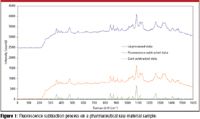
Figure 1
Another common issue that engineers must address is the focusing point of the laser and fiber-optic collecting device. When determining the focusing point of a Raman probe, engineers should consider the fact that the laser will be interacting with the molecules that are closer to the focal point of the laser radiation. For example, in a freestanding solid, the focusing point should be at the surface of the sample. A powder inside a plastic bag should be analyzed considering the thickness of the plastic film in an effort to avoid collecting Raman data from the polymer material. This becomes more important when analyzing liquids because they are generally in glass or plastic containers that have very different thicknesses; therefore, the focal point should be deep into the sample to avoid the vial's material interference. The containers also can have a significant vibrational contribution to the results. If this contribution is in the same area of interest as the studied subject, it will be necessary to use a different container or an alternate excitation wavelength. The examples in Figure 2 and Figure 3 show how a glass vial Raman signal interfered during the determination of fat content of milk samples. The spectra in Figure 2 show the raw signal for the samples in glass vials, while the spectra in Figure 3 show the same samples analyzed in quartz cuvettes.
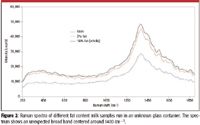
Figure 2
These examples clearly show how a glass vial Raman signal interfered during the determination of fat content of milk samples. The vial's broad signal from 1250 to 1650 cm–1 clearly overwhelms the expected Raman peaks coming from milk's fat.
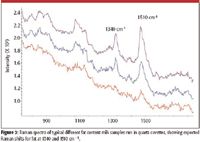
Figure 3
Although low-resolution Raman focus to date is as a materials identification technique, using direct measurements and chemometric algorithms for substances fingerprinting as the identification tool, more and more applications are being developed for semiquantitative analysis of mixture components (process and quality control) and unknown mixtures (forensic and other applications), and even for structural determination of molecules as was originally intended. In this area, the commercial application becomes challenging because the instruments start to compete with other analytical techniques. To obtain significant quantitative results, we must consider that as a technique, Raman in general is not capable of trace analysis due to its sensitivity constraints; we can detect one Raman scattered photon from each one million photons used as excitation. Its quantitative capability depends, as with most other techniques, upon having the proper standard reference materials, homogeneous samples, matrix interactions (similar issues to the aforementioned container interference example), and most importantly, the capability of the analyzed substance to scatter photons efficiently (the sample must be Raman active).
In general, Raman is capable of analysis down to 0.1–1% concentrations of materials in different matrices. This means that depending upon the application, this will be a suitable technique even for complicated systems such as the quantification of urea or glucose in blood for medical purposes or the end-of-mix determination in a pharmaceutical mixing process. At the same time, it can be difficult to pinpoint the amount of cocaine in a white powder mixture confiscated by law enforcement. In the first case, we can assume that the urea–blood mixture is homogeneous and consistent, while in the latter, the mixing process of cocaine and filler generally is deficient and inconsistent. Furthermore, the medical and pharmaceutical mixtures are not only homogeneous but also standardized. This matrix is always the same and known, the raw materials are controlled, and there are reference standards available for preparing accurate calibration protocols.
The forensic example of determining cocaine in a mixture is more complicated because different fillers or a mixture of fillers (talc and sodium bicarbonate, or a mixture of both) can be used for "cutting" down the pure cocaine. In this case, several analyses and their average might be required in order to try to find a high-concentration "spot" on the sample. Obviously, liquid samples are easier to analyze because they tend to be homogeneous mixtures or solutions. Slurries and suspensions have a higher limit of detection due to solid scattering (non-Raman) of the excitation source. Powder mixtures have the worst detection limit as a result of particle size effect on proper mixing. The detection limit and sensitivity for large solids such as ceramics, gems, paper, polymeric materials, and others will depend upon the matrix interaction and crystalline structure used to identify impurities or even phase concentrations.
On the positive side, the technique's ability to monitor specific parts of larger molecules will generate opportunities in the polymers and pharmaceutical industries. Polymerization reactors generally are designed under stringent conditions to avoid explosions and accidents due to the common use of volatile solvents. The use of optical probes to monitor and control catalytic parameters such as the rate of polymerization makes this technique ideal from a safety point of view because no electrical wires need to be close to the reactor. Even more interesting is its ability for continuous on-line monitoring of the reaction, which will cut production and testing costs and even help the process to go from a batch process to a semicontinuous one. Other techniques, such as near-infrared (NIR) and Fourier-transform infrared (FT-IR) spectroscopy and chromatography, tried to achieve the same safety and economical advantages with limited success due to complicated and time-intensive chemometric or sampling requirements. It is also important to highlight that low-resolution Raman spectroscopy is feasible thanks to later developments in laser and detector improvements in quality, size, and cost.
The exponential growth of low-cost, handheld instruments is allowing the Raman technique to be transferred to new markets every day. Today you can find specialized instrumentation to analyze the content of different fats and pigments (carotenoids) in fish such as salmon and tuna. Raman spectroscopy also can be used to "virtually" determine fish freshness. As an example, the presence and concentration of dimethylamine in frozen fish (1) is directly related to the freezing temperature and age of the frozen fish, ensuring the quality of the food and providing better standards for shelf life. Other common applications in the food industry are the determination of edible oils quality, composition, and even adulteration. Low-resolution Raman is an easy-to-use technique to determine fat's composition, concentration, and saturation (2). This has significant economic, nutrition, and health impacts in the industry. Unfortunately, vegetable oil adulteration is a common practice in this market, in which unscrupulous merchants use low-cost oils to dissolve higher-priced commodities, which has enormous financial effects but also has caused fatal health issues such as the famous case in Spain where more than 700 persons died in 1989 (3). At that time, the determination of the cause of death took weeks, whereas today it can be avoided easily by a 30-s Raman measurement at the receiving dock of the oil distributor.
Gemology is another field that is taking advantage of low-resolution Raman. Now it is easy and affordable to determine the quality of precious and semiprecious gems using portable fiber-based Raman spectrometers. In Figure 4, we can see how new instruments and appropriate software can identify different kinds of gems based upon minimal changes to their Raman signature.
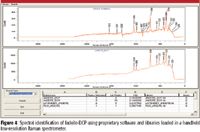
Figure 4
Even more financially important than determining the quality and structure of gems and precious stones or edible components could be the identification of drug counterfeiting (4). This common and dangerous practice can involve any of the required components to manufacture a pharmaceutical product or even the final product with the inherent health consequences for the consumer.
Pharmaceutical companies formulate their products not only based upon their active ingredients, which can be protected by intellectual property laws and regulations, but on other raw materials as well. These companies are careful in their choice and concentration of other raw materials and excipients so that they can trace the final product back not only to their company but even to a specific manufacturing facility. As mentioned earlier, low-resolution Raman is becoming a preferred technique for PAT. To develop and validate a process technique, it is important that the actual measuring method be scalable by the production plant. Therefore, although the measurement can be validated by other systems, it is imperative to use the same instrument to create the method that will be used on-line for process control. This was one of the main problems that Raman had in the pharmaceutical industry until the advent of fiber optics–based Raman.
Today, a low-cost spectrometer can be placed in a laboratory to develop the method by analyzing all the raw materials, formulations, or combinations, creating a library and required chemometric models to generate reliable calibration curves. The same probes, fibers, lasers, and spectrometer are then scaled up to a pilot plant facility to validate the method at larger production capacity, and finally are scaled up to the manufacturing floor. Because drug manufacturers can produce the same pharmaceutical product in different parts of the world, they can determine the presence of any of their products by the fingerprint created by local raw materials, different mixers and extruders (which might require different amounts of lubricants or binders, for example), and other factors that can affect the final composition of the drug without changing the quality or concentration of the actual active ingredient. More importantly, they can determine whether a drug was manufactured at one of their facilities or by an authorized generic manufacturer, or if it is a counterfeit.
Although the new instrumentation is reliable, sturdy, and easy to use, it is important to emphasize the need for proper analytical procedures utilized with expensive laboratory-based instruments. Analytical instruments constantly experience performance variations due to temperature cycling, pressure and mechanical-related stress, and optical decay, resulting in the degradation of their designed performance parameters. In Raman spectroscopy, these and other changes affect the performance of the laser and the spectrometer, so it is important to consider appropriate calibration and maintenance procedures as part of any method development. Spectrometers' wavelength monitoring and calibration generally require a reference light source. High-purity gas or vapor light sources are the primary standards for testing wavelength accuracy, with mercury and argon light sources being the most commonly used. Light sources such as a mercury vapor lamp are recommended by testing organizations such as ASTM, International Pharmacopoeia entities, and other organizations. The laser power output can be measured by a power meter or, even better, can be tested at the excitation interface, which is the tip of a probe or optical focus point. This can be accomplished by using Raman relative intensity standards developed by NIST (4). These standards are specially designed fluorescent glasses that are sensitive to specific laser wavelengths such as the NIST-SRM-2241 for the 785-nm lasers.
Low-resolution Raman spectroscopy is limited only by the imagination and requirements of the market. Each day, new instruments and applications move forward to be used by scientists and nonscientists alike in highly specialized areas or commonly used applications. Due to constant miniaturization, continuous improvements, and cost cutting, this technique has the potential to become as common as measuring pH, temperature, or pressure.
Extensive work and proper equilibrium between the advantages and limitations of the technique will lead to the development of feasible instruments for market-specific applications. Both handheld devices and modular systems have a future in markets as varied as manufacturing plants, medical laboratories, and law enforcement fields all the way to food distribution centers and exiting new fields such as nanotechnology.
Jorge J. Macho and Andrew Tatsch are with Ocean Optics, Inc., Dunedin, Florida.
References
(1) A.M. Herrero, P. Carmona, and M. Careche, J. Agric. Food Chem. 52(8), 2147–2153 (2004).
(2) E.F. Olsen, E.O. Rukke, A. Flatten, and T. Isaksson, Meat Science 76-4, 628–634 (2007).
(3) Alan Riding, Special to The New York Times, May 21, 1989.
(4) M.R Witkowski, American Pharmaceutical Review 8-1, 56–62 (2005).
(5) S.J. Choquette, E.S. Etz, W.S. Hurst, D.H. Blackburn, and S.D. Leigh, Appl. Spectrosc. 61-2, 117–129 (2007).
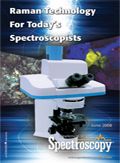
AI-Powered SERS Spectroscopy Breakthrough Boosts Safety of Medicinal Food Products
April 16th 2025A new deep learning-enhanced spectroscopic platform—SERSome—developed by researchers in China and Finland, identifies medicinal and edible homologs (MEHs) with 98% accuracy. This innovation could revolutionize safety and quality control in the growing MEH market.
New Raman Spectroscopy Method Enhances Real-Time Monitoring Across Fermentation Processes
April 15th 2025Researchers at Delft University of Technology have developed a novel method using single compound spectra to enhance the transferability and accuracy of Raman spectroscopy models for real-time fermentation monitoring.
Nanometer-Scale Studies Using Tip Enhanced Raman Spectroscopy
February 8th 2013Volker Deckert, the winner of the 2013 Charles Mann Award, is advancing the use of tip enhanced Raman spectroscopy (TERS) to push the lateral resolution of vibrational spectroscopy well below the Abbe limit, to achieve single-molecule sensitivity. Because the tip can be moved with sub-nanometer precision, structural information with unmatched spatial resolution can be achieved without the need of specific labels.